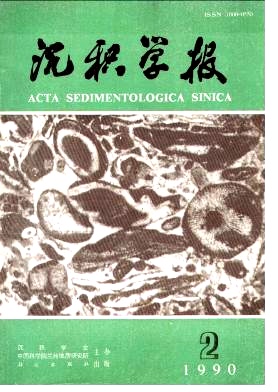SEDIMENTARY CHARACTERISTICS AND ORE-CONTROLLING FACTORS OF "SILICEOUS ROCK- CARBONATE ROCK- MUDROCK"TYPE STRATABOUND URANIUM DEPSITS OF MIDDLE SILURIAN IN WEST QINLING RANGE
- Received Date: 1988-01-04
- Publish Date: 1990-06-10
Abstract: Siliceous rock-carbonate rock-mudrock" type stratabound uranium deposits refer to those occured in special lithologic formations consisting mainly of siliceous rocks, carbonate rocks and mudrocks. Presently, this kind of ore deposits is one of the unique types of uranium deposits in China.The Silurian in this area is also called Bailongjiang Group which is a suit of fine-grained terrigenou. clastic rocks such as siltstone, mudstone and sandstone, interbedded with siliceous rocks, and carbonaterocks.The Middle Silurian series of orefield in the area can be fallen into three: Yangchanggou Formation Taer Formation, and Lalong Formation. The lower part of each formation consists of fine- grained terrigenous clastic rocks, the upper part of each formation consists of siliceous rocks, carbonate rocks and mudrocks. Almost all of the uranium deposits are occured in the strata of siliceous rocks, carbonat rocks ami mudrocks, upper part of each formation of Middle Silurian.According to the comprehensive reserch of sedimentary facies of Silurian, two facies areas have beet recognized: the restricted shelf facies area in western region, and the open shelf facies in eastern region.The former can be subdivided into: restricted inner shelf facies, gulf facies, and the comples of orgam reef/ shoal facies and tidal flat/ lagoon facies (isolated platform facies) . The latter can be subdivides into: inner-outer shelf facies, and the neritic shoal facies. As a result of discovering of Stromatopora organ ic reef and other shallow-water criteria, a entirely new view of lithofacies arid paleogeography of Silurian in this area has been obtained. In Silurian, it should belong to a marginal neritic environment in north of deep sea environment believed by earlier authors. Because of the existence of Baiyi subaqueous uplift, a isolated platform was developed in the restricted inner shelf environment during the reef- forming period of Middle Silurian, and formed the special complex of organic reef/ shoal facies and tidal flat/ lagoon facies.Eastwardly, it was a open shelf to sub-deep marine environment in this period.The uranium deposits are obviously controlled by the strata and lithofacies. Both the uranium sources and mineralizer came from the strata of siliceous rocks, carbonate rocks and mudrocks.It can be concluded that the uranium deposits in this area are typical stratabound deposits reformed by midium-lower temperature hydrothermal solutions based on the nature of ore-forming solutions, the physico-chemical conditions and the metallogtenic epoch.The ore-controlling factors for the uranium deposits are mainly as follows:(1) The strata of "siliceous rock-carbonate rock-mudrock" of Middle Silurian.(2) The complex of organic reef/ shoal facies and tidal flat/ lagoon facies, the main roles include: I. the lagoon facies is favourable for forming of uranium sourcebeds, Ⅱ the lithologic formations in the complex is favourable for enrichment of uranium during the metallogeic processes.(3) The uranium deposits in the orefield are almot dstributed along the nearly EW faulting structures.(4) The preserval conditions of uranium deposits.
| Citation: | lang Zhaohui, zeng Yuntu. SEDIMENTARY CHARACTERISTICS AND ORE-CONTROLLING FACTORS OF "SILICEOUS ROCK- CARBONATE ROCK- MUDROCK"TYPE STRATABOUND URANIUM DEPSITS OF MIDDLE SILURIAN IN WEST QINLING RANGE[J]. Acta Sedimentologica Sinica, 1990, 8(2): 33-42. |






 DownLoad:
DownLoad: